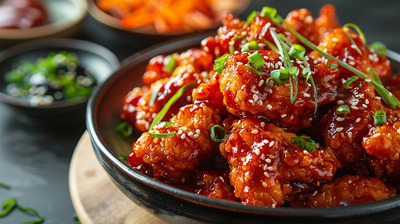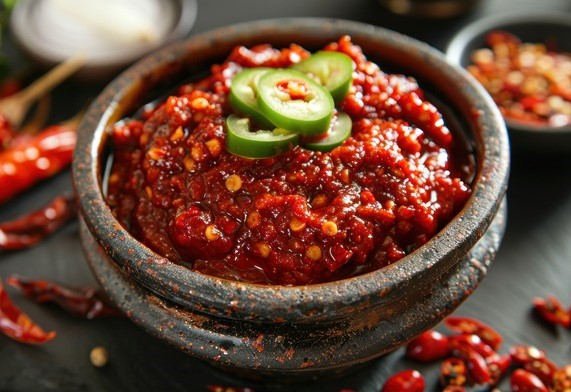Gochujang is more than just a spicy paste—it is a complex ingredient that combines several key components to create its signature flavor. Understanding the active ingredients that make up Gochujang, as well as its unique flavor profile, allows us to see why this condiment has become a cornerstone of Korean cuisine. Additionally, the culinary possibilities it offers are seemingly endless, as it can be used in a variety of recipes that highlight its multifaceted character.
Active Components of Gochujang
The foundation of Gochujang lies in the balance of five main ingredients: red chili peppers, glutinous rice, fermented soybeans, salt, and sweeteners. Each component plays a crucial role in contributing to Gochujang’s flavor, texture, and nutritional profile.
1. Red Chili Peppers: The Source of Heat
Red chili peppers provide Gochujang’s signature heat, with capsaicin being the active compound responsible for its spiciness. Capsaicin is more than just a flavor enhancer; it has been linked to several health benefits, including:
- Improved metabolism
- Anti-inflammatory properties
- Pain relief
- Boosting immune health with vitamin C and antioxidants
Chili peppers in Gochujang offer more than just heat. The fermentation process mellows the sharpness of the spice, resulting in a more balanced and lingering warmth rather than an intense burn.
2. Glutinous Rice (Sweet Rice): Sweetness and Texture
Glutinous rice, also known as sweet rice, provides a subtle sweetness that balances out the spiciness of the chili peppers. During fermentation, the rice breaks down into sugars, contributing to the paste’s thick, sticky texture.
- Sweetens the paste naturally through fermentation
- Adds a chewy, sticky texture ideal for sauces and marinades
- Provides complex carbohydrates, making it a good source of energy
Glutinous rice is crucial to the fermentation process and gives Gochujang its smooth and spreadable consistency, allowing it to cling to meats and vegetables when used as a marinade or sauce.
3. Fermented Soybeans: The Heart of Umami
Fermented soybeans are the main source of umami in Gochujang. Umami, often described as a “savory” or “meaty” taste, deepens the flavor of the paste and makes it more complex.
- Rich in amino acids that contribute to the umami flavor
- Soybeans are packed with protein, iron, magnesium, and calcium
- Fermentation produces probiotics, which can benefit gut health
The long fermentation process transforms the soybeans, releasing glutamate (the compound responsible for umami), giving Gochujang a savory richness that lingers on the palate.
4. Salt: Preserving and Enhancing Flavor
Salt serves multiple functions in Gochujang:
- Acts as a natural preservative, allowing the paste to ferment over time
- Controls the fermentation process by inhibiting harmful bacteria while promoting the growth of beneficial microbes
- Enhances the overall flavor by balancing sweetness, umami, and heat
Too much salt can overpower the delicate flavors of Gochujang, but when used correctly, it ties together the paste’s different elements.
5. Sweeteners (Optional): Balancing the Heat
Depending on the recipe or brand, Gochujang may include additional sweeteners like barley malt syrup, honey, or brown sugar. These sweeteners play an essential role in balancing the heat from the chili peppers and creating a harmonious flavor profile.
- Barley malt syrup or brown sugar adds depth to the sweetness
- Honey provides a natural, mild sweetness that balances spiciness
- Some variations focus more on sweetness for milder Gochujang, while others emphasize heat
The level of sweetness varies between Gochujang products, making some better suited for specific recipes like sauces or marinades.
The Flavor Profile of Gochujang
A Multi-Layered Taste Experience

Gochujang is a paste that tantalizes the taste buds with its complex layers of flavor. The paste offers a perfect blend of:
- Heat from chili peppers
- Sweetness from glutinous rice and optional sweeteners
- Saltiness from salt
- Umami from fermented soybeans
The fermentation process deepens and enriches these flavors, resulting in a paste that is far more than just spicy. Each bite brings together sweet, savory, and spicy elements, making it a versatile ingredient for various dishes.
Heat and Sweetness: A Delicate Balance
Gochujang’s spiciness is complemented by the sweetness derived from the rice and optional sweeteners. This balance makes the paste suitable for a variety of palates, ranging from those who prefer mild heat to spice lovers who enjoy a stronger kick.
- Milder Gochujang varieties focus more on sweetness and umami.
- Spicier versions turn up the heat, appealing to those who love bold flavors.
- Length of fermentation impacts flavor: longer fermentations result in a more intense umami taste, while shorter fermentations produce a lighter, sweeter flavor.
Umami and Fermentation
Umami is the secret ingredient that gives Gochujang its depth. The fermentation process allows the soybeans to develop complex amino acids, creating a savory richness that enhances the paste’s overall flavor.
- Long fermentation results in more pronounced umami flavors.
- Fermentation adds probiotic benefits, contributing to gut health.
The longer Gochujang ferments, the more intense and rich the flavor becomes, making it highly prized in traditional Korean cooking.
Popular Recipes Featuring Gochujang
The versatility of Gochujang makes it a popular ingredient in a wide variety of Korean dishes, as well as in fusion recipes that incorporate flavors from other cuisines. Let’s explore some of the most popular dishes that showcase Gochujang’s unique taste.

1. Gochujang Chicken Wings
A fusion of Korean and Western flavors, Gochujang chicken wings are a popular appetizer that combines the sticky sweetness of traditional buffalo wings with the heat and complexity of Gochujang.
- Ingredients: Chicken wings, Gochujang, soy sauce, garlic, honey
- Method: Marinate the wings in a mixture of Gochujang, soy sauce, garlic, and honey, then bake or fry until crispy.
- Taste: Sweet, spicy, and savory with a bold kick from the Gochujang glaze.
The result is a dish that is sweet, spicy, and savory all at once, perfect for game day or parties.
2. Spicy Korean BBQ Marinade
Gochujang is often used as the base for Korean barbecue marinades, particularly for beef and pork. The paste is combined with ingredients like soy sauce, sesame oil, garlic, and sugar to create a rich, flavorful marinade that tenderizes the meat.
- Ingredients: Gochujang, soy sauce, sesame oil, garlic, sugar
- Method: Marinate the meat (beef or pork) for several hours, then grill to perfection.
- Taste: Spicy, sweet, and smoky with a slight caramelization from the sugar in the marinade.
This marinade is commonly used for dishes like bulgogi (thinly sliced marinated beef) and dak galbi (spicy grilled chicken).
3. Gochujang Stir-Fry Sauce
For a quick and easy weeknight meal, Gochujang can be used to create a flavorful stir-fry sauce. This sauce clings to vegetables and proteins, making every bite spicy, savory, and aromatic.
Ingredients: Gochujang, soy sauce, rice vinegar, sesame oil, sugar, freshly grated ginger.
Method: Stir-fry vegetables and protein with ginger until fragrant. Toss in the Gochujang sauce mixture and continue cooking until well coated. Serve over rice.
Taste: A perfect balance of spice, sweetness, and umami with an added warmth and zing from the ginger, and a hint of tang from the vinegar.
4. Gochujang Mayo
Mixing Gochujang with mayonnaise creates a spicy, creamy condiment that is perfect for sandwiches, burgers, and fries. This simple combination transforms ordinary dishes into something special.
- Ingredients: Gochujang, mayonnaise
- Method: Mix Gochujang with mayo and use it as a spread or dip.
- Taste: Creamy with a spicy kick, perfect for adding heat to burgers or dipping fries.

5. Kimchi Fried Rice with Gochujang
Kimchi fried rice is a staple of Korean comfort food, and adding Gochujang to the dish elevates it to the next level. The paste enhances the spicy, tangy flavor of the kimchi, while also adding a hint of sweetness and umami.
Taste: Spicy, tangy, and savory with a rich, creamy yolk from the fried egg.
Ingredients: Cooked rice, kimchi, Gochujang, vegetables, egg
Method: Stir-fry rice with kimchi, Gochujang, and vegetables, then top with a fried egg.
6. Bibimbap with Gochujang
Bibimbap is a popular Korean dish consisting of rice, vegetables, and protein, all topped with a generous spoonful of Gochujang. The paste adds a spicy kick that brings the dish together.
- Ingredients: Rice, assorted vegetables, Gochujang, egg, beef or tofu
- Method: Arrange the vegetables and protein over rice, top with Gochujang, and mix everything together before eating.
- Taste: A symphony of textures and flavors—spicy, sweet, savory, and earthy.
Tips and Notes for Using Gochujang
Storage and Shelf Life
- Storage: Always store Gochujang in an airtight container in the refrigerator. If kept properly, it can last for up to a year. Over time, the fermentation process may deepen the umami flavor.
- Shelf Life: While it lasts long, it’s best to use within six months for the freshest taste. If you notice any change in color or smell, discard it.
Adjusting the Spice and Substitutes
- Heat Level: Gochujang’s spice level varies depending on the brand. Therefore, check the label for spice intensity. If you prefer a milder taste, you can mix it with more sweeteners or use less in your dish.
- Substitutes: If you can’t find Gochujang, you can make a quick substitute. Combine red chili flakes (or sriracha), miso paste, soy sauce, and honey. However, remember that the flavor will not be exactly the same.
Serving Size and Cooking Tips
- Serving Size: Typically, recipes use about 1-2 tablespoons of Gochujang. If you’re new to it, start with a smaller amount and gradually increase based on your spice preference.
- Cooking Tip: Since Gochujang contains sugar, it caramelizes quickly. Thus, it’s best to use it in marinades or cook it with liquids to prevent burning.
Dietary Considerations and Health Benefits
- Allergy Information: Gochujang often contains soy and can sometimes include gluten (from barley or wheat). Always check the label if you have dietary restrictions or need a gluten-free option.
- Vegan-Friendly: Although many versions are vegan, some might include fish-based products like anchovy extract. Therefore, always double-check the ingredients to ensure it’s vegan-friendly.
- Health Benefits: Gochujang is rich in capsaicin from chili peppers, which may help improve metabolism and reduce inflammation. Additionally, it contains probiotics from fermentation, which are good for gut health. It’s also a source of antioxidants.
Flavor Profile and Ideal Pairings
- Flavor Enhancer: Gochujang is well known for adding depth and balance to dishes. It brings together heat, sweetness, and umami, making it ideal for marinades, soups, stews, and sauces.
- Best Pairings: Gochujang pairs exceptionally well with meats like beef, pork, and chicken. Additionally, it complements tofu, vegetables, rice, noodles, and fermented foods like kimchi. It’s a must-have in BBQ and stir-fry dishes.

